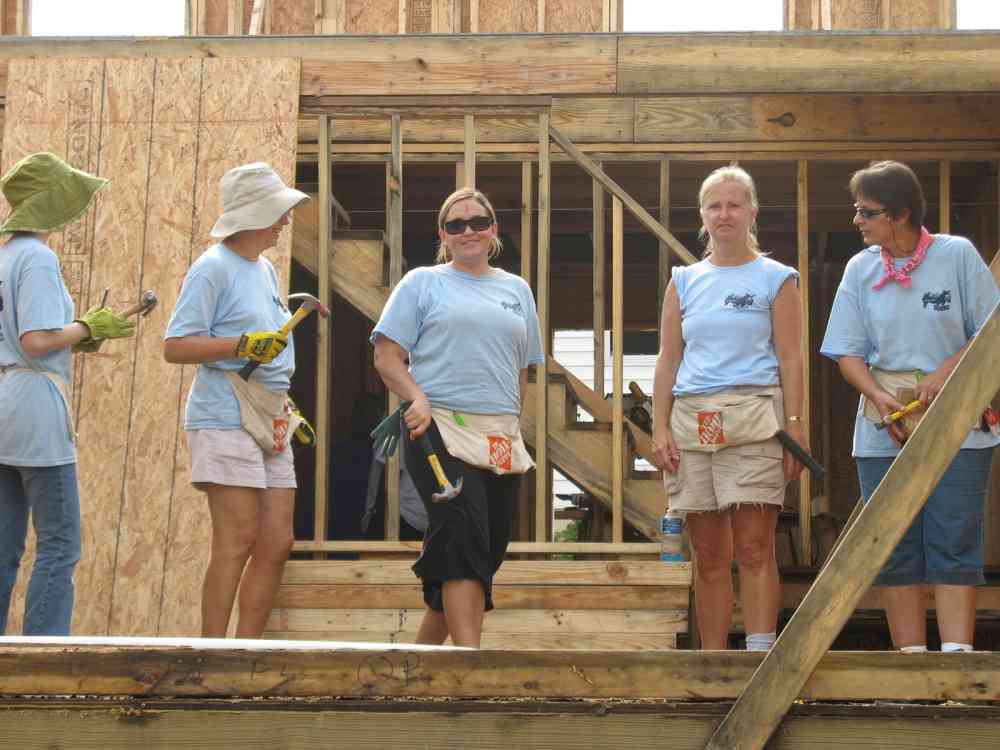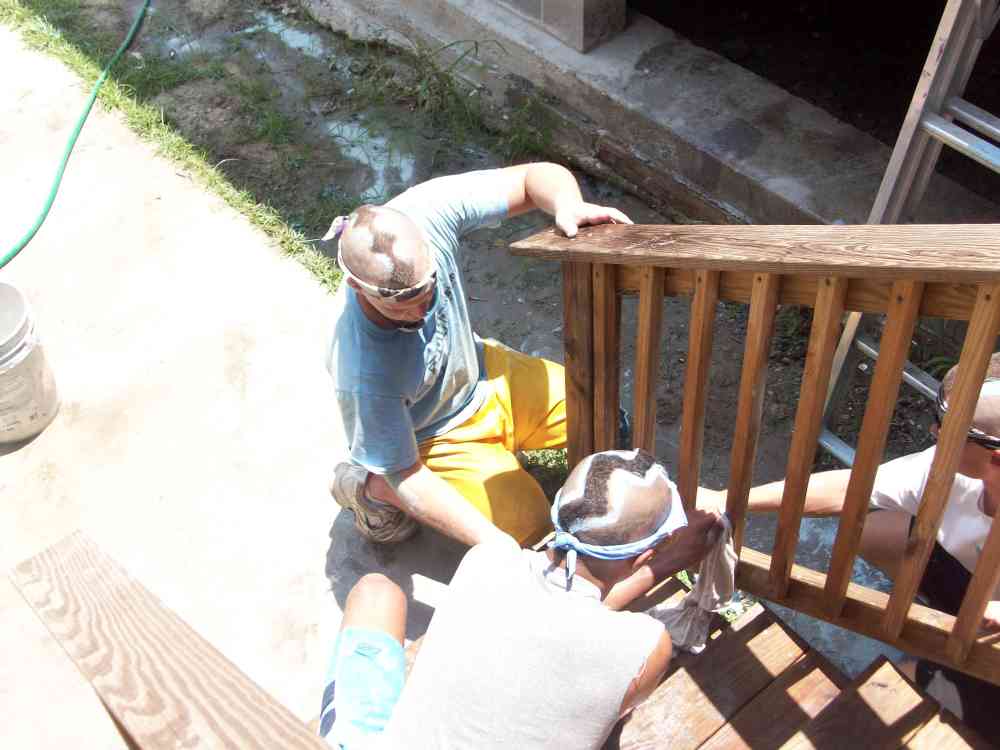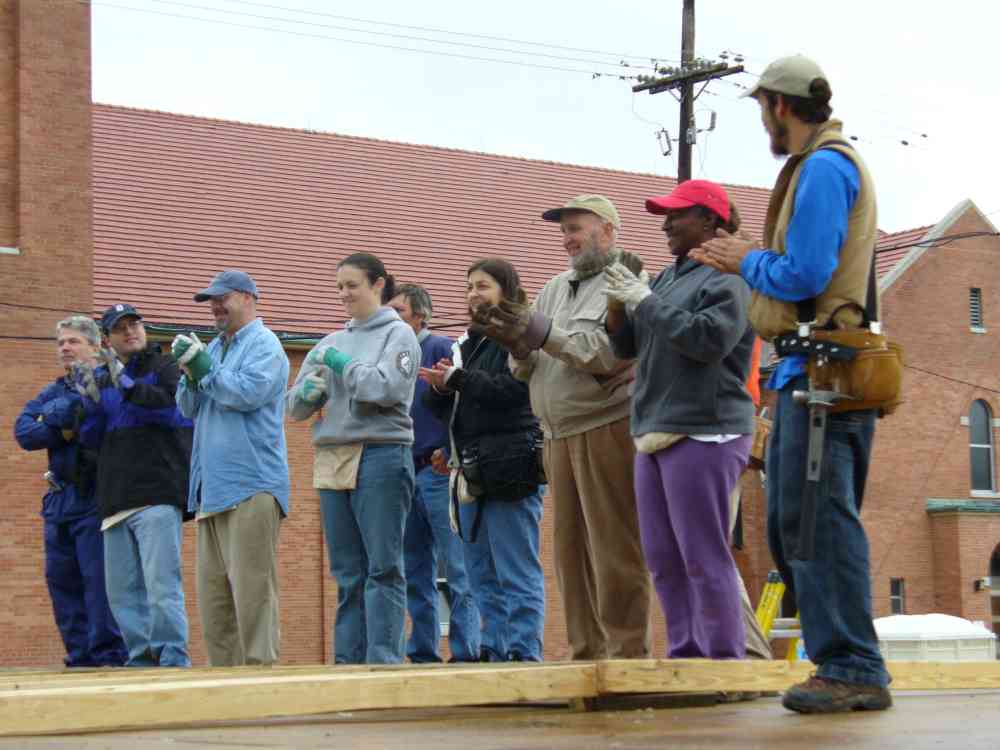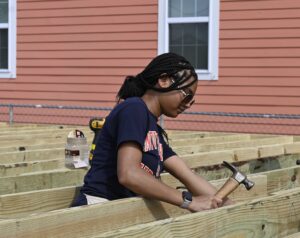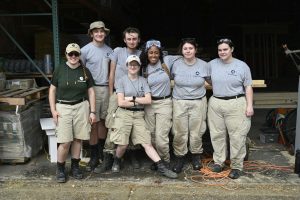Having volunteered before, Avery Strada, the current program director with RHINO, had some connection to the city before she moved here with her husband in 2009. Without finding jobs first, they came to the city because they knew they had to be a part of the rebuilding efforts. In a short time, with her experience with volunteering and working with youth ministries, Strada was able to take her energy and passion for New Orleans and become part of the communal response to the disasters of 2005.
That same communal response, that of thousands of volunteers from around the country (and the world), was the rare silver lining in the narrative of the storm’s aftermath, and it inspired one of NOAHH’s most enduring post-Katrina relationships: Rebuilding Hope in New Orleans (RHINO) began in the wake of Hurricane Katrina and the levee failures as part of the commitment St. Charles Avenue Presbyterian Church (SCAPC) had for the city.
With over 100 years of service in the city, SCAPC’s roots are deep in the New Orleans community. In the aftermath of the storm, the church knew it had to find a way to help the city rebuild, as they put it, physically and spiritually, and they had many people contacting them to find out how they could help. With resources relatively low at that time, the church took what it had to achieve their mission.
What they offered was hospitality, shelter, meals, and guidance and organization. Churches from across the nation were calling to help. Soon hundreds of volunteers were arriving in groups as small as two (but often much larger) to help out, as RHINO started their coordinating operations.
Because the infrastructure was not entirely in place just after the storm, the nonprofit group started out gutting houses. Diana Likely painted a vivid portrait of what the city was like in the early days after the storm:
“That first year in New Orleans, wounds were still fresh, and we were welcomed, literally, with open arms, everywhere we went. Complete strangers threw their arms around us and ‘God blessed’ us when they heard why we had come… Church volunteers guided us on tours around the area, from barbed wire-topped chain link fences along the 17th Street Canal breach, wrecked pleasure boats piled near the destroyed yacht club, to the unimaginable devastation of the Lower 9th Ward, where twisted shells of houses lay atop crushed and rusting pickup trucks, homemade signs declared sites where lives had been lost, and everywhere the ground was still covered with a gray-brown crust of dried mud. Every house in the flood zone bore the fluorescent ‘X’ that told the story of its inhabitants, and the lucky ones that still stood were marked with a brown line that told how high the water had risen.”
Within a year, however, RHINO and NOAHH had formed a partnership that would become one of the most consistent and long lasting volunteer partnerships that NOAHH formed after Hurricane Katrina.
“Hardly a week goes by that we don’t have some RHINO volunteers helping us out on site,” said Jim Pate, executive director of NOAHH. “The consistency of their presence is something we don’t take for granted. Their dedication is more than we could have asked for, and we can’t thank them enough for that.”
Between September and June, RHINO volunteers can be found on Habitat homes in New Orleans, and during the summer months, when possible, attendees of Camp RHINO can sometimes be found on site. Their dedication to rebuilding the city has grown and adjusted with NOAHH’s, and over the years, this partnership has produced seven sponsored homes, 29 homes built, 6,000 volunteers from over 30 states, and an entire city block reinvigorated. Estimating conservatively, RHINO volunteers have worked at least 200,000 hours over the last 8 years.
“We’ve made a commitment to this city. Since 1983, we’ve been fighting poverty housing in the New Orleans area, and after the federal flood and Hurricanes Katrina and Rita, we knew we had to step up for this city. Having partners like RHINO stand alongside us made it possible,” said Pate.
From the beginning, RHINO was a flexible organization. What began as a response to an influx of requests from people around the country soon became a formal mission of the church. As requests for aid grew in number, so did the organization. Volunteers like Carro Gardner joined in the coordinating efforts. Gardner had evacuated the city to Florida, and the warmth and compassion she found there inspired her to return that love whens he returned home. As need for remediation changed, she said, so did the organization. When she started with the organization, she had volunteered help with the backlog of requests for aid, and now she serves as a RHINO Ministry board member.
In that same vein, what started out as dormitory style bunks in the church’s education building evolved into an arrangement with the Brent House Hotel. In the early days, volunteers shared part of their accommodations with the church’s sexton and his family, as they had been displaced by the storm. While the space seemed crowded at times, with a small kitchen and only two bathrooms, long time volunteer Diana Likely pointed out that compared to some other sites, it was luxurious, as it had food, air conditioning, and hot water, amenities some volunteer camps could not provide due to the effects of the disaster. In 2006, few hotels were able to make such arrangements. By 2008, the camp had moved to Brent House, which Likely noted was another sign of the city’s progress.
“Word spread that RHINO was doing good work, gutting homes and then building homes, and people just came. I honestly believe it’s a calling of this church to have this RHINO ministry and do this work,” Strada said of the growth of the organization.
Similarly, as time passed, RHINO’s partnership with NOAHH expanded. Seeing the impact and potential of Musicians’ Village (which many RHINO volunteers worked on), Pastor Don Frampton sought to make a similar contribution to the city’s recovery. From this came the revitalization of Ferry Place, a single block street in the Leonidas/Pensiontown area of New Orleans, near Jefferson Parish, discovered by a pastor at SCAPC who was also a city planner. Before RHINO and NOAHH teamed up to build 14 homes there, the street was practically abandoned. Blight and trash, overgrown weeds and burnt out houses dominated the street. Minor hiccups along the way delayed construction, particularly the need to install sewer lines, but by 2007, work on the block had begun.
Diana Likely told the story of her first visit to Ferry Place: “2007 was my first year as a team leader, and I brought 30 volunteers from St. Louis. We worked on the first two houses to be completed, Woodie [Horne]’s and Jenika [Sly]’s, installing Tyvek and windows and hanging siding. We also began a third house, completing footings and installing floor joists. Emotions in the city had begun to heal during the intervening year, but we became friends with the new home owners as we worked side by side with them and with others putting in their sweat equity. We were fortunate to have the finest quality RHINO coordinators, who were ‘hands on’ leaders, and to meet the highly committed young folks from AmeriCorps.”
As RHINO team after RHINO team came to town, Ferry Place grew and flourished. Within two years, every home on the block was complete, the last home being finished by December of 2009. What had once been a blighted, empty street was now a beautiful row of new homes, and none of it would have been possible without RHINO.
But their commitment to the neighborhood did not end at Ferry Place. RHINO volunteers helped with almost every other Habitat home built in the neighborhood, and the church sponsored and built a community garden at a local school. The whole neighborhood became a focus of RHINO’s efforts, and many who work with RHINO live there, including Avery Strada. According to Kate Snider, former program director at RHINO and Strada’s predecessor, “It was so rewarding for our volunteers to return year after year and see the progress not only of Ferry Place but also in other parts of the neighborhood. It created a sense of investment, kept people connected, and gave a sense of needing to return.”
“What we once thought might be the end or crowning glory of the Rebuilding Hope in New Orleans (RHINO) ministry of St. Charles Avenue Presbyterian Church has turned out to be just the beginning,” said Dave White, tour guide coordinator and RHINO Ministry board member.
White also tells the story of Woodie Horne, a Habitat homeowner who, at the time, was working on his sweat equity hours. Every week, when White was volunteering in Musicians’ Village (before Ferry Place was under construction), Horne would arrive on his bicycle several days of the week to put in work toward owning his home. Rain or shine, White says, Horne would ride his bike to the sites, continuing to show up when construction shifted to Ferry Place. Horne and the RHINO volunteers became close while working together, and somehow, by the end of it, Horne had done nearly four times the required sweat equity hours. In September of 2008, the Hornes and their granddaughter became the second family to move in on Ferry Place. Over the years, RHINO volunteers from that time have kept in contact with Horne on their return visits to the city, forming a bond that has helped inspire them to remain a part of the city’s recovery.
As White puts it, “This, indeed, is a labor of love.”
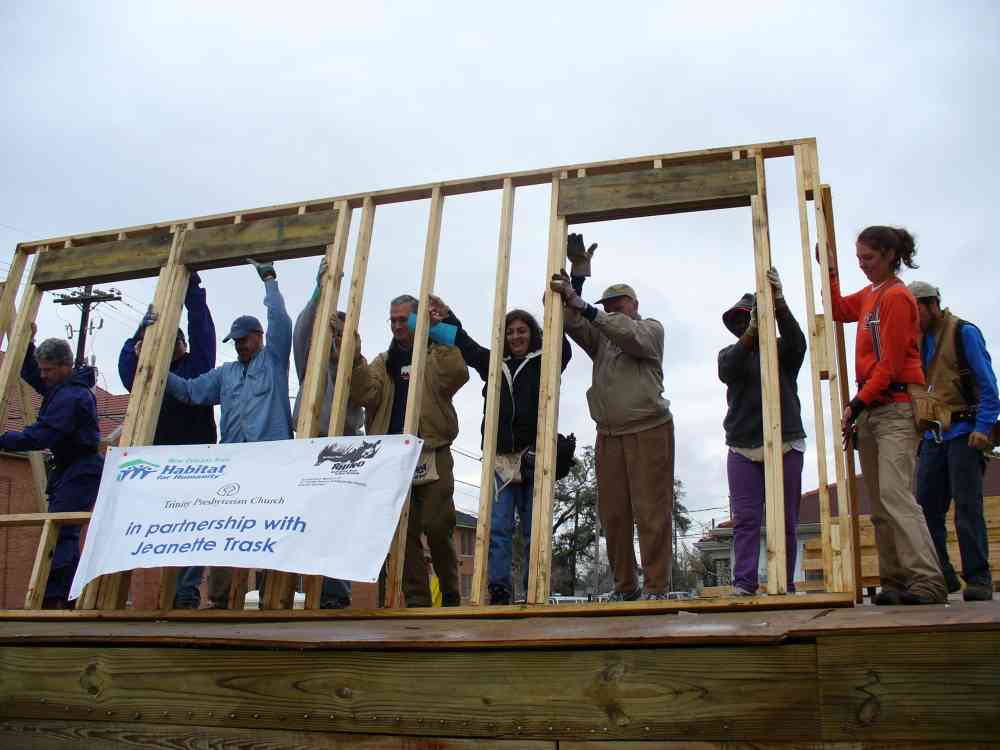
That spirit of compassion flowed both ways, according to several of the volunteers from RHINO. Strada points out that in all of her trips to help other areas, none have had the same level of outward gratitude. It is a quality that is remarked upon again and again.
“I vividly recall the number of times people thanked us. At first it was overwhelming; everywhere we went, even driving down the streets, people would wave at our church bus and say, ‘Thank you!'” said Rachel Martin, a Presbyterian volunteer from Sarasota, FL. “We came to New Orleans to help where we could; we left changed people with a feeling that we had made a difference, but knowing there was still so much work to be done in that wonderful city.”
Since her first trip in 2007, she has returned eight times, and now recruits teams for her church. A typical volunteer week, she said, would start with the teams arriving and finding the church had set up every detail, including meals and housing. They are given an orientation about NOAHH and told about the homeowners of any homes they may be working on that week. On the work sites, they have been involved in every aspect of the homebuilding process, from floor systems to trusses to interior work.
“With each trip I worked with RHINO, we arrived ready to work, and learn new ways to contribute to the rebuilding of New Orleans,” she said.
Another perk of volunteering through RHINO is the chance to meet members of the community through the church, which allows the volunteers to feel even more connected to the city. The sense of camaraderie engendered by the hard work required of the volunteers is evident in Likely’s descriptions. Days of hard work were followed by nights of shared chores and meals, interactions with church members and hosts. In the early days after the storm, with resources low, the makeshift nature of the organization reinforced the sense of community found between the volunteers and those they were helping.
“I feel like a non-resident SCAPC member and look forward each fall to reuniting with these folks,” she said, adding later, “During the week our team of 30, mostly from Salt Lake City and St. Louis, bonded into a unit that was able to work together almost intuitively. When a need for help arose, it was filled immediately without asking. It was the most intensely emotional, exhausting and rewarding week of my life, and I couldn’t wait to return to what had become the hometown of my heart.”
RHINO volunteers leave the city a little better than it was before they came, and they leave the city a little better than they were before they came. Between the connections they make here and the skills they learn, they gain something on every visit. The bonds RHINO and NOAHH have formed have engendered this long term, mutually beneficial growth.
“Every time I go to work with RHINO and Habitat, I leave loving New Orleans a little more, and knowing that my work has made a difference,” Martin said. “I have helped build many new houses, I have learned new skills, I have rebuilt some hope, and because of me, one day, one more family is going to have a place to call home.”
And that personal growth here in New Orleans inevitably ends up benefitting the communities they come from. Jim Pate makes a habit of encouraging the volunteers he speaks with to find the affiliate in their own hometowns and support them, and RHINO volunteers have, whether they have spoken with Pate or not, taken up this advice.
“Some of the greatest testimonies to come out of the RHINO program are the stories of how people who have come down to volunteer return home and apply the same spirit to their own communities,” Snider said. “We have a volunteer from Seattle who now works on the Wednesday crew with his local affiliate. And a church in Cary, NC, was so inspired by their work in New Orleans that they sponsored a build with their local affiliate.”
Furthermore, RHINO has since expanded to taking trips to other disaster-affected areas, in what they have informally begun calling “reverse RHINO trips.” Local New Orleanian members give back to communities around the nation by helping them recover in the same way so many volunteers have come here to help us recover.
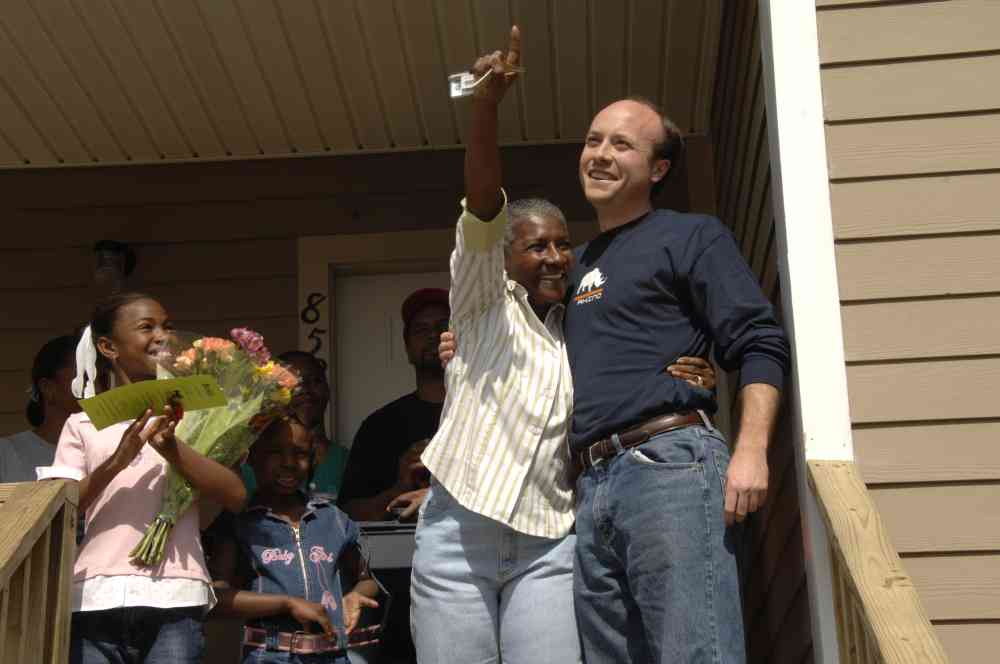
Along with expanding to include these trips, RHINO is expanding locally as well, finding other ways to help in the city. According to Avery Strada, RHINO won’t stop with merely addressing housing issues. “Hurricane Katrina brought to light other issues: homelessness, poverty, crime education. It’s all on the surface. With RHINO’s other community partners, we can rebuild hope in completely different ways.”
The city has come a long way since 2005, of course, and RHINO has been a part of that recovery. According to Kate Snider, “RHINO is about community and relationships and working together to achieve a common goal. It was a revelation to return to Ferry Place in 2008 and realize the hundreds of volunteers who had come during our absence to continue the work.”
Each of the RHINO volunteers contacted continue to do good in their communities, whether it be New Orleans or abroad. Eight years of partnership have turned them into a familiar presence on the work sites, and our commitment to each other has no end in sight. As NOAHH celebrates its 30th anniversary, we have recommitted ourselves to New Orleans, looking to find new ways and partnerships to make the city better. RHINO, similarly, has embraced their role as coordinators of thousands of volunteers, each one coming to the city to help make it a better place.
“As long as there is a need for Habitat, we’re going to be here,” said Pate. “And it’s clear that RHINO has that same sort of drive.”
“My favorite quote is from a video we took,” Strada said, describing a comment that inspired her. “He said, ‘We’ve done so much, and we’ve come so far as a city that we can’t stop. New Orleans needs us to fully recover. Why would we ever stop now?'”
